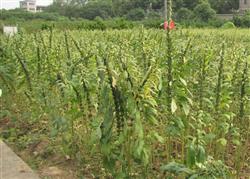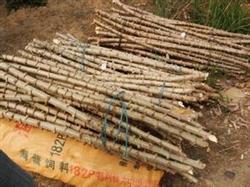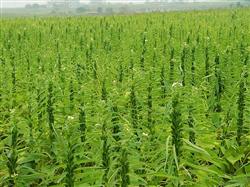How to fertilize sesame seeds

According to research, sesame's demand for nitrogen is less in the early stage and more in the middle and late stages; the demand for phosphorus is less in the early stage, sufficient in the middle stage and more in the late stage; the demand for potassium is less at both ends and more in the middle, that is, the potassium required from the 6-leaf stage to the peak stage of sesame accounts for 95% of the total potassium required in the whole growth period. According to the law of sesame fertilizer requirements, the following links should be mastered in the specific operation of fertilization. First of all, we should carefully cultivate the land and apply sufficient base fertilizer. Sesame soil requirements are not very strict, but because sesame seeds are small, roots do not penetrate deep, must have a fine tilled land, and then apply enough base fertilizer to obtain high yield. The soil should be cleaned up to make it easy to fertilize. Base fertilizer should be combined with organic fertilizer and inorganic fertilizer, and simple fertilizer should be combined with multi-element fertilizer. One is to apply decomposed organic fertilizer, 1500~2000 kg per mu, preferably 40 kg of organic compound fertilizer with enzyme bacteria, which can not only improve the soil, but also enhance the activation function; or apply decomposed cake fertilizer 30 kg per mu, and apply 25 kg of high-content ternary compound fertilizer. However, fresh organic fertilizer or single nitrogen fertilizer should not be used in the base fertilizer. One is to prevent burning seedlings when fertilizer is fermented, and the other is to prevent long and thin seedlings. Secondly, proper amount of seed fertilizer should be mixed and fertilized in time. Sesame seed nutrient content is limited, only timely fertilizer can cultivate strong seedlings. Each mu of seeds can be mixed with 250 kg of fine soil fertilizer ash, or 5~8 kg of fine cake fertilizer, or about 2 kg of urea, to prevent excessive seed fertilizer burning seedlings. Third, according to the local conditions, promote the balanced growth of seedlings. For sesame seedlings with poor soil quality and weak growth, it is advisable to chase decomposed human excrement and urine for seedling extraction. After flowering, quick-acting nitrogen fertilizer should be applied with water, urea 5~7.5 kg per mu, and strip application is advocated instead of spreading. For the vigorous sesame seedlings, topdressing or spraying delayed plant growth regulators should be controlled, such as 1 g of chlorhexidine or 4 ml of chlorhexidine per mu and 15~20 kg of water. Fourth, the use of appearance advantage, to carry out root topdressing. Sesame stems and leaves hairy more, larger leaf area, root topdressing is easy to adhere to, absorb and transform. Therefore, foliar fertilizer is a good way to supplement fertilizer, one can increase capsule number, two can increase seed weight, three can improve seed oil yield. For topdressing, 2%~3% calcium superphosphate solution can be used, 1%~2% urea solution can be used, 0.2% boron fertilizer solution can be used, and 500~800 times solution of Huimanfeng active liquid fertilizer can be used. The above three fertilizers can be mixed with Huimanfeng active liquid fertilizer for spraying.
- Prev

High-yielding cultivation techniques of cassava in spring
First, dig deeply to improve the soil. A month before planting cassava, turn the soil over and whiten the soil to make the soil fully weathered. When planting, 250 kilograms of phosphate fertilizer composting with livestock manure was applied per mu as base fertilizer. Second, select improved varieties. Varieties with more tubers, less toxicity and high yield must be selected. And select the stem.
- Next

Key points of cultivation and management of sesame
Most farmers believe that sesame is a low-yield, drought-tolerant crop with extensive management. As a result, the yield per mu of spring sesame is less than 150 kg over the years, and that of summer sesame or intercropped sesame is less than 100 kg. The experiment shows that as long as the improved varieties are added and the cultivation measures are improved, the yield of sesame can be increased by more than 20%. First, Shi.
Related
- The first cup of black tea in spring, the flavor and history of tea gardens in Kenya, Africa
- The computer can not only choose potatoes, but also grow tea rice. AI will grow winter oolong tea champion.
- It is not only the inflated tea bitten by insects, but also engraved with the four seasons tea in Beipu.
- The Oriental Beauty Tea Festival in Zhuxian County takes the stage at the weekend to experience the plus-size feast of oil tea.
- & quot; Oriental Beauty Tea & Exploration of Emei in Hsinchu, the hometown of quot;
- The new variety of strawberry "Tainong 1" dessert is the first choice with mellow aroma. Crimson gorgeous
- History of Tea in Taiwan: from Wild Inner Mountain to Export Tea Garden
- Two types of Taiwan Oriental Beauty Black Tea won the British three-Star Award for Childhood Tea Xiang Zhang Jiaqi changed from pilot to champion tea maker.
- Banana species and varieties: the planting history of Taiwan Xianren banana and dwarf banana is long, is banana disease resistant?
- Coffee planting Technology: Qianjie Coffee from Seedling to harvesting

